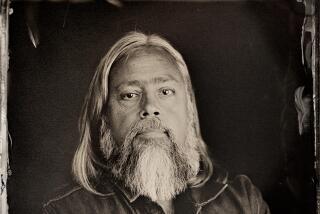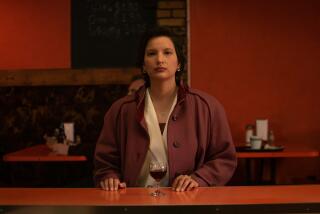‘Little Tree’: Simple Tale of Wisdom Blossoms
- Share via
Granma said when you come on something good, first thing to do is share it with whoever you can find; that way, the good spreads out where no telling it will go. Which is right.
--From “The Education of Little Tree”
At a moment in American literary history when the public appetite for Kitty Kelley-esque sensationalism seems unending, a low-key, low-budget book about a Cherokee boyhood in the 1930s would seem an unlikely candidate for popular success.
Yet “The Education of Little Tree,” the late Forrest Carter’s reminiscence of Appalachian Mountain life with his American-Indian grandparents, is approaching a quarter-million copies without benefit of a promotional campaign, press kit, TV talk circuit or even an advertising budget.
Why?
“Everyone who reads it wants to share it,” says admirer Lia Levin, a Los Angeles musician.
And Wednesday, the nation’s booksellers singled it out for a new award. “Little Tree” won the first ABBY award from the American Booksellers Assn.; ABA members voted it the book they most enjoyed selling through their own recommendations, rather than by publisher promotion. The $5,000 prize will be presented at the ABA’s June meeting in New York.
“I think it’s a wonderful prize--this book has just been an extraordinary success,” says Elizabeth Hadas, director of the University of New Mexico Press, where “Little Tree” has been viewed with amazement since its paperback publication in 1986. It sold 2,000 copies for New Mexico Press its first year out, doubled that the second year and snowballed since.
“As of today we’ve shipped out 237,000 copies and will soon reach a quarter of a million,” Hadas said last week in a telephone interview. Such figures are virtually unheard of in university press circles, where a typical press run is 2,000 copies.
The paperback is a reissue of a 1976 Delacorte Press book that won critical acclaim, sold a few thousand copies and then was discontinued, leaving behind a small cult following.
Its synopsis would hardly meet today’s publishing-world demands for high-concept action material. It’s a simple narration by a boy, adopted by his Cherokee grandparents who name him Little Tree and teach him their American Indian philosophy: how to live without fear or cynicism, how life works if you respect and care for your natural surroundings and the people around you.
In a series of adventures, Little Tree learns what his grandfather calls “the Way,” a lifestyle of living in harmony with the environment and of never taking more than you need.
The unique blend of wisdom and humor that underlies Little Tree’s education is typified during his first hunt, when his grandfather taught him to live with the game, not against it.
While white hunters clattered all over the mountains with their dogs, shooting every turkey they could find, Little Tree learned to dig a hole and trap live turkeys. (They actually could have escaped the trap, his Granpa noted, but, like some people, the turkeys have their heads stuck so high in the air they can’t learn anything.) Of the six trapped turkeys, Little Tree and Granpa took only the three they needed, releasing the rest. Returning home, Little Tree reflects on the experience:
“I followed Granpa down the trail. The turkey was heavy, but it felt good over my shoulder. The sun had tilted toward the farther mountain and drifted through the branches of the trees besides the trail, making burnt gold patterns where we walked. The wind had died in that late afternoon of winter and I heard Granpa, ahead of me, humming a tune. I would have liked to live that time forever . . . for I knew I had pleased Granpa. I had learned The Way.”
Hadas describes the poignant book as an Indian “Huckleberry Finn,” whose child protagonist turns out to be wiser than the people running the society that victimizes him: “It teaches you to follow your own voice, it gives you a sense of morality that you find within yourself and not within social dictates. It’s the voice of a child--very pure and very musical.”
The book seems to meet a universal need, says Hadas: “I think a lot of kids read it, but a lot of old people read it too. There are people buying it for their grandchildren. We can tell from the letters we get.”
Not only is the book a natural for the growing environmental consciousness, she says, it’s being used in “an astonishing variety” of classes--not only literature and American Indian history but also adult literacy classes. And at least one criminal justice class she has heard from requires it for future law-enforcement officers, emphasizing its cross-cultural view of society.
“I have a feeling it speaks to people who have not read anything like it before,” Hadas adds. “I think this book presents a whole new view of what ‘education’ means.”
“Little Tree” was an odd catalogue addition for the University of New Mexico Press in Albuquerque. During its 60-year history, it has established a reputation for publishing substantial and scholarly books on anthropology, history and culture of the American West.
“The book found us,” says Hadas.
It was sent by Eleanor Friede, who had been a co-publisher of the book with Delacorte Press and continued to represent the rights after the author died and the book was discontinued.
Friede wanted to get it back in circulation. “I was getting a dozen letters a month from people asking how they could get the book,” she said by phone from Charlottesville, Va., where she now lives. “I was desperate to get it back into print but couldn’t interest any reprint editor in New York because it didn’t fall into any recognizable category.”
She called the University of New Mexico Press because she knew they published books about American Indians.
“I’d never heard of it,” says Hadas, who was an editor at the time, “but I said ‘Sure,’ so she sent me a copy. I read it, though it seemed an unlikely choice for a scholarly press.
“I cried when I got to the end and thought, ‘Gee, I don’t usually cry over the books we publish.’ I told my boss it was a terrific book but different because it doesn’t take place in the Southwest. He talked to a couple of experts on Native American history--including Rennard Strickland of Southern Illinois University, who wrote the foreword--and we bought the book out.
“It turned out to be great. It has been almost completely word-of-mouth. We didn’t do a big marketing campaign.”
Friede represents the author’s widow, India Carter, and will accept the ABBY award at the June convention. She has understood the book’s appeal since she first read it: “Timing is very important. It’s what we need right now for the times. We want somebody to tell us the truth, the real values, not ‘Alice in Wonderland,’ not fairy tales.”
A typical fan is Barbara Blinderman of Los Angeles, a public interest attorney and president of Mulholland Tomorrow, a legal foundation organized to protect the Mulholland Scenic Corridor. A friend gave her the book, and she has since bought “about three dozen copies and given them to absolutely everybody.”
“I liked the environmental point of view, but it goes beyond that. It’s about what we are trying to preserve, which is our sense of dignity as individuals. . . . It says that people do count, and there’s more to life than going to a shopping mall.
“I think the appeal is to the meaning of life. It tells the truth in a way that’s very rare in this 30-second bite, public-relations-generated world today.”
WISDOM OF ‘LITTLE TREE’
The Indian never fishes or hunts for sport, only for food. Granpa said it was the silliest damn thing in the world to go around killing something for sport. He said the whole thing, more than likely, was thought up by politicians between wars when they wasn’t gittin’ people killed so they could keep their hand in on killing. Granpa said that idjits taken it up without a lick of thinking at it, but if you could check it out--politicians started it. Which is likely.
The mourning dove calls late at night and never comes close. He calls from far back in the mountain and it is a long, lonesome call that sounds like he is mourning. Granpa said he is. He said if a feller died and didn’t have anybody in the whole world to remember him and cry for him, the mourning dove would remember and mourn. Granpa said if you died somewheres far off, even across the great waters, that if you was a mountain man you would know you would be be remembered by the mourning dove. He said it lent a matter of peace to a feller’s mind, knowing that. Which I know it did for my mind.
--From “The Education of Little Tree”
More to Read
Sign up for our Book Club newsletter
Get the latest news, events and more from the Los Angeles Times Book Club, and help us get L.A. reading and talking.
You may occasionally receive promotional content from the Los Angeles Times.










